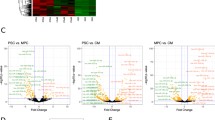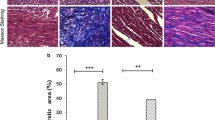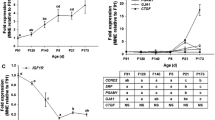Abstract
MicroRNAs (miRNAs) are small noncoding RNAs that are involved in key biological processes, including development, differentiation, and regeneration. The global miRNA expression profile that regulates the regenerative potential of the neonatal mouse heart has not been reported. We performed deep sequencing to determine the genome-wide miRNA expression profile of the neonatal mouse heart at three key ages (1, 6, and 7 days). The miRNAs at least 1.4-fold differentially expressed between the three time points were selected for further analysis. Two miRNAs (mmu-miR-22-5p and mmu-miR-338-3p) were significantly upregulated, and nine miRNAs (mmu-miR-324-5p, mmu-miR-337-5p, mmu-miR-339-5p, mmu-miR-365-1-5p, mmu-miR-500-3p, mmu-miR-505-5p, mmu-miR-542-5p, mmu-miR-668-3p, and mmu-miR-92a-1-5p) were significantly downregulated in cardiac tissue of 7-day-old mice compared to 1- and 6-day-old mice. The expression patterns of five significantly different miRNAs were verified by quantitative real-time PCR. Furthermore, the potential targets of these putative miRNAs were suggested using miRNA target prediction tools. The candidate target genes are involved in the myocardial regenerative process, with a prominent role for the Notch signaling pathway. Our study provides a valuable resource for future investigation of the biological function of miRNAs in heart regeneration.



Similar content being viewed by others
References
Bartel, D. P. (2009). MicroRNAs: Target recognition and regulatory functions. Cell, 136, 215–233.
Lagos-Quintana, M., Rauhut, R., Lendeckel, W., & Tuschl, T. (2001). Identification of novel genes coding for small expressed RNAs. Science, 294, 853–858.
Mendell, J. T. (2005). MicroRNAs: Critical regulators of development, cellular physiology and malignancy. Cell Cycle, 4, 1179–1184.
Yin, V. P., Lepilina, A., Smith, A., & Poss, K. D. (2012). Regulation of zebrafish heart regeneration by miR-133. Development Biology, 365(2), 319–327.
Poss, K. D., Wilson, L. G., & Keating, M. T. (2002). Heart regeneration in zebrafish. Science, 298(5601), 2188–2190.
Oberpriller, J. O., & Oberpriller, J. C. (1974). Response of the adult newt ventricle to injury. Journal of Experimental Zoology, 187(2), 249–259.
Porrello, E. R., Mahmoud, A. I., Simpson, E., Hill, J. A., Richardson, J. A., Olson, E. N., et al. (2011). Transient regenerative potential of the neonatal mouse heart. Science, 331(6020), 1078–1080.
Lau, N. C., Lim, L. P., Weinstein, E. G., & Bartel, D. P. (2001). An abundant class of tiny RNAs with probable regulatory roles in Caenorhabditis elegans. Science, 294, 858–862.
Jopling, C., Sleep, E., Raya, M., Martí, M., Raya, A., & Belmonte, J. C. I. (2010). Zebrafish heart regeneration occurs by cardiomyocyte dedifferentiation and proliferation. Nature, 464(7288), 606–609.
Thatcher, E. J., & Patton, J. G. (2010). Small RNAs have a big impact on regeneration. RNA Biology, 7(3), 333–338.
Liu, N., & Olson, E. N. (2010). MicroRNA regulatory networks in cardiovascular development. Developmental Cell, 18(4), 510–525.
Kuhl, C., Atzberger, A., Iborra, F., Nieswandt, B., Porcher, C., & Vyas, P. (2005). GATA1-mediated megakaryocyte differentiation and growth control can be uncoupled and mapped to different domains in GATA1. Molecular and Cellular Biology, 25(19), 8592–8606.
Caprioli, A., Koyano-Nakagawa, N., Iacovino, M., Shi, X., Ferdous, A., Harvey, R. P., et al. (2011). Nk2–5 represses Gata1 gene expression and modulates the cellular fate of cardiac progenitors during embryogenesis. Circulation, 123(15), 1633–1641.
Fu, X., Tan, D., Hou, Z., Hu, Z., Liu, G., Ouyang, Y., et al. (2012). The effect of miR-338-3p on HBx deletion-mutant (HBx-d382) mediated liver-cell proliferation through cyclinD1 regulation. PLoS One, 7(8), e43204.
Takeuchi, J. K., & Bruneau, B. G. (2009). Directed transdifferentiation of mouse mesoderm to heart tissue by defined factors. Nature, 459(7247), 708–711.
Ieda, M., Fu, J. D., Delgado-Olguin, P., Vedantham, V., Hayashi, Y., Bruneau, B. G., et al. (2010). Direct reprogramming of fibroblasts into functional cardiomyocytes by defined factors. Cell, 142(3), 375–386.
Malekar, P., Hagenmueller, M., Anyanwu, A., Buss, S., Streit, M. R., Weiss, C. S., et al. (2010). Wnt signaling is critical for maladaptive cardiac hypertrophy and accelerates myocardial remodeling. Hypertension, 55, 939–945.
Kemi, O. J., Ceci, M., Wisloff, U., Grimaldi, S., Gallo, P., Smith, G. L., et al. (2008). Activation or inactivation of cardiac Akt/mTOR signaling diverges physiological from pathological hypertrophy. Journal of Cellular Physiology, 214, 316–321.
Stoick-Cooper, C. L., Weidinger, G., Riehle, K. J., Hubbert, C., Major, M. B., Fausto, N., et al. (2007). Distinct Wnt signaling pathways have opposing roles in appendage regeneration. Development, 134(3), 479–489.
Falix, F. A., Aronson, D. C., Lamers, W. H., & Gaemers, I. C. (2012). Possible roles of DLK1 in the notch pathway during development and disease. Biochimica et Biophysica Acta, 1822(6), 988–995.
Xu, K., Usary, J., Kousis, P. C., Prat, A., Wang, D. Y., Adams, J. R., et al. (2012). Lunatic fringe deficiency cooperates with the Met/Caveolin gene amplicon to induce basal-like breast cancer. Cancer Cell, 21(5), 626–641.
De Lange, R. P., Burr, K., Clark, J. S., Negrin, C. D., Brosnan, M. J., St Clair, D. M., et al. (2001). Mapping and sequencing rat dishevelled-1: A candidate gene for cerebral ischaemic insult in a rat model of stroke. Neurogenetics, 3(2), 99–106.
Raya, A., Koth, C. M., Büscher, D., Kawakami, Y., Itoh, T., Raya, R. M., et al. (2003). Activation of notch signaling pathway precedes heart regeneration in zebrafish. Proc Natl Acad Sci USA, 30(100 Suppl 1), 11889–11895.
Acknowledgments
This study was supported by Grants from the National Natural Science Foundation of China (Nos. 81070138 and 81200126) and the National Natural Science Foundation of Jiangsu Province of China (No. BK2010582).
Author information
Authors and Affiliations
Corresponding authors
Additional information
Liu HL and Zhu JG contributed equally to this work.
Rights and permissions
About this article
Cite this article
Liu, H.L., Zhu, J.G., Liu, Y.Q. et al. Identification of the microRNA Expression Profile in the Regenerative Neonatal Mouse Heart by Deep Sequencing. Cell Biochem Biophys 70, 635–642 (2014). https://doi.org/10.1007/s12013-014-9967-7
Published:
Issue Date:
DOI: https://doi.org/10.1007/s12013-014-9967-7




